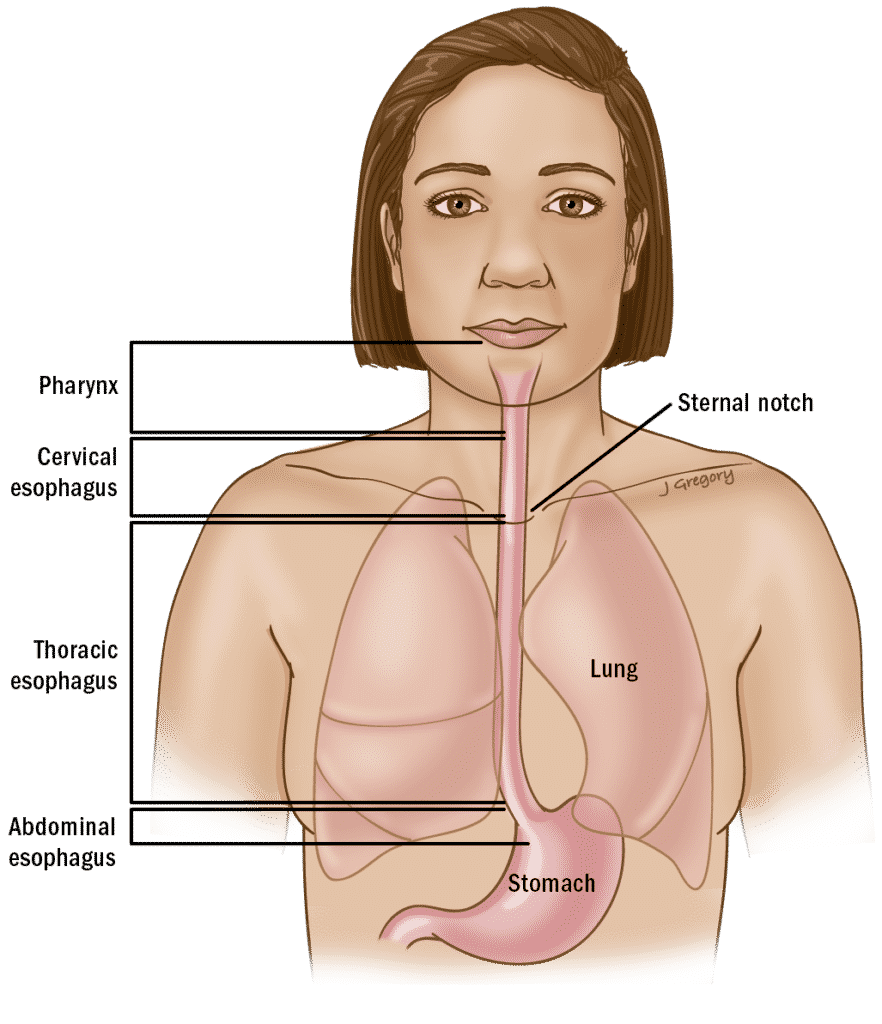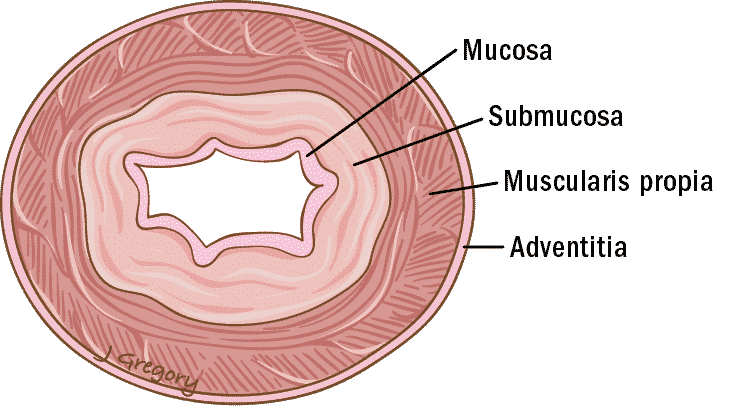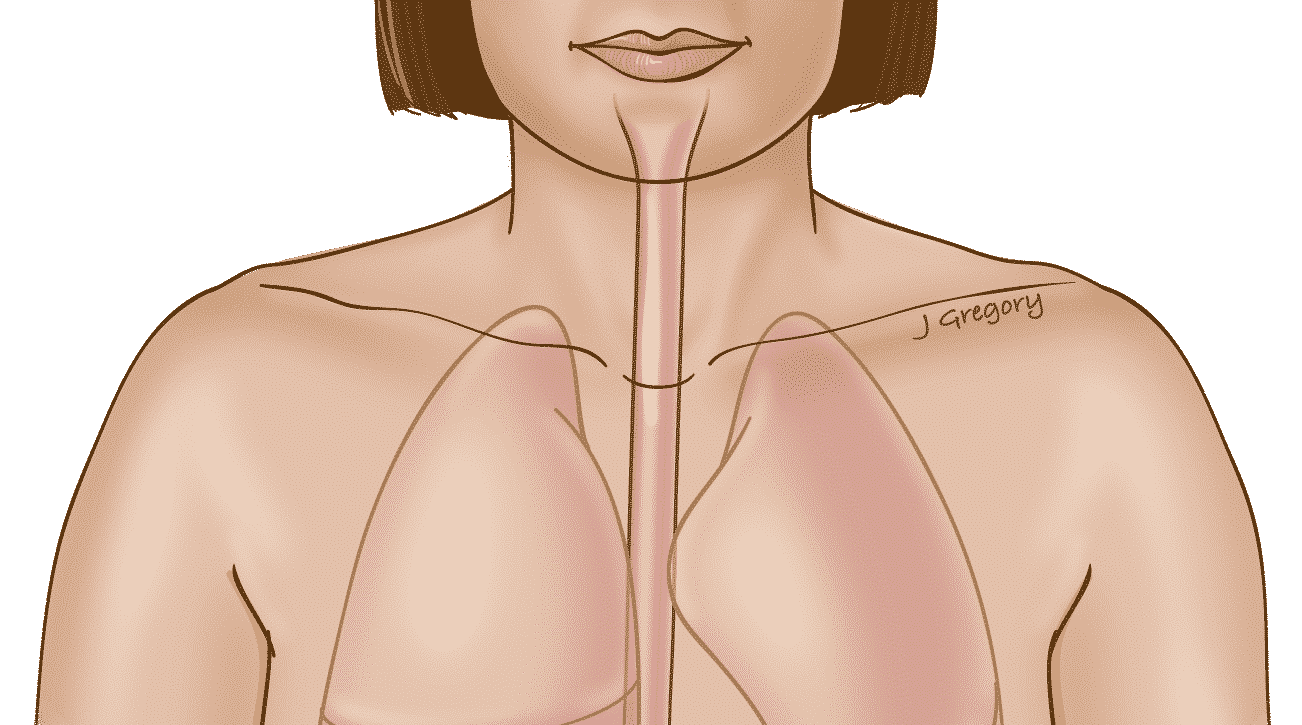
What & Where is the Cervical Esophagus?
Cervical esophageal cancer, characterized by growth in the esophagus’s upper part, often stems from genetic and environmental factors, with tobacco use significantly heightening risk. Symptoms like difficulty swallowing, weight loss, neck lumps, or pain necessitate immediate medical consultation. Diagnosis involves exams, endoscopy, imaging, and biopsy, with treatments including surgery, radiation, and chemotherapy offering hope for affected individuals.
Cervical Esophagus Anatomy
In order to understand cervical esophageal cancer, it helps to understand the anatomy of the region. The esophagus is a muscular tube lined by mucosa that carries food and liquids from the throat into the stomach. It runs through the central portion of the neck behind the trachea just in front of the spine.
On each side of the esophagus are the carotid sheaths, which contain the carotid artery, jugular vein, and vagus nerve. Since the esophagus begins in the lower neck, cancers in this region are often considered to be throat cancers. Esophageal cancers are often classified by measuring the distance from the teeth to the top of the tumor.

Causes, Signs & Symptoms
Cervical esophageal cancer often has no definitive cause, because it results from a complex combination of genetics and environmental factors. However, we have listed below a few known risk factors for developing cervical esophageal cancer.
Risk Factors for Cervical Esophageal Cancer
- Radiation Exposure.
- Plummer-Vinson Syndrome.
Common Causes of Cervical Esophageal Cancer
- Tobacco
- Alcohol
Common Symptoms
- Pain in the Throat.
- Difficulty Swallowing.
- Weight Loss.
- Lump in the Neck.
- Ear Pain.
Additional Symptoms
- Hoarse Voice.
- Coughing every time liquids are ingested (if the cancer has invaded the nerves to the voice box).
- Feeling of something stuck in the throat.
- Bleeding (coughing or vomiting blood).
Diagnosis
The diagnosis of cervical esophageal cancer can be difficult and overwhelming. Further testing will be necessary to confirm a diagnosis and determine the best course of treatment. Imaging, endoscopy, and biopsy are generally standard diagnostic approaches. Patients can expect their doctor to have a discussion with them about the risks, benefits, and alternatives to each of the following.
Type, Grade & Stage
After diagnosing a patient with cervical esophageal cancer, a doctor will need to determine what type of cancer it is, the grade of the tumor, and the stage of the cancer. Doctors often establish a preliminary disease stage based on physical exam as well as findings on imaging that helps to identify the spread of disease.
Staging esophageal cancer requires special tests, such as endoscopic ultrasound, that a head and neck surgeon typically does not perform. Because of this, a head and neck surgeon will consult either a gastroenterologist or a thoracic surgeon. This is in addition to a team of radiation oncologists and medical oncologists. In patients who undergo surgery, the care team will determine a well-defined disease stage based on pathology after surgery.
Treatment Plan
After determining a diagnosis and completing a full pre-treatment evaluation, doctors will recommend a course of treatment for their patients.
In general, there are 3 different options for the treatment of cervical esophageal cancers that can be used alone or in combination: surgery, radiation, and chemotherapy.
Prognosis
A prognosis is a prediction of the outcome of one’s disease. How likely is survival? Will the cancer come back? These are the big questions on most people’s minds after receiving a diagnosis of cervical esophageal cancer.In general, there are 6 tumor characteristics that can inform a patient about their chances of being cured: the stage, the site, the type & grade, the spread to lymph nodes, the tumor margins and the spread into local structures.
What to Expect After Treatment
After treatment, patients should follow-up with their doctors on a regular basis.
Patients should visit their head and neck specialist on a regular schedule (or earlier if they have any concerning symptoms). This allows doctors to monitor the patient for any sign that the cancer has returned. The best timeline for follow-up will be determined by the doctor.












